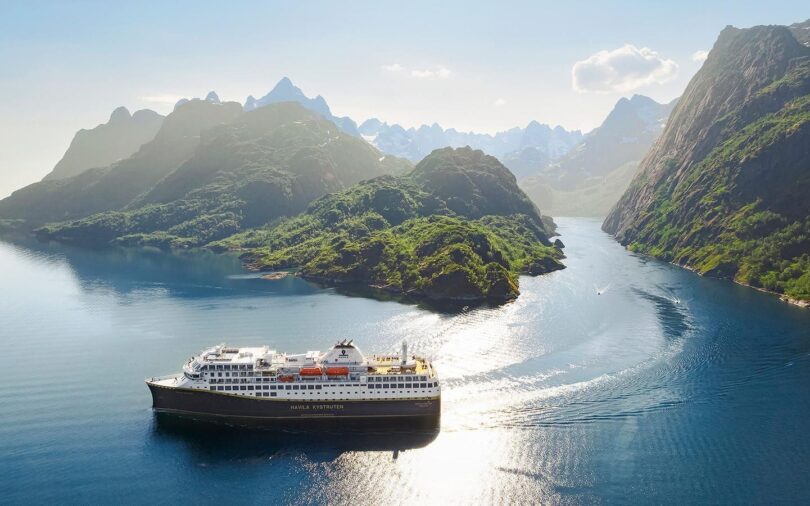Norway’s coastal ferry service has been ferrying local passengers and carrying international … [+]
This year, Norway’s historic coastal ferry is finally back in full daily operation after the disruption caused by the pandemic and delays to new vessels. It also marks the 130th anniversary of the coastal route.
International travelers know the route as an 11-night roundtrip cruise-like experience from Bergen to Kirkenes, which is a popular way to see the Norwegian coastline. It’s especially popular among German, British, and American tourists, many of whom do the route year after year.
But in Norway, the service is best known for its local transport of passengers and cargo along the coastline, something that has been in place with government support since 1893.
The Norwegian government supports the route financially, using private companies to deliver the service.
At least ten different shipping companies have operated ferries on the coastal route over its 130-year history, with Hurtigruten the best known. That’s because from 2006 to 2021, only Hurtigruten ferries operated on the route.
Since 2021, two companies—Hurtigruten and Havila—operate ferries on the coastal route. Over an 11-day period, Hurtigruten runs seven of the daily departures and Havila the other four.
Whether choosing a departure operated by Hurtigruten or Havila, passengers joining the coastal ferry will be taking part in a historic voyage.
The Beginning of Norway’s Coastal Route
Prior to 1893, mail delivery in the north of Norway was an unpredictable, lengthy process. With very few roads, almost all transport of mail, goods, and people took place by boat.
Hurtigruten and Havila ships still carry cargo to this day.
The Norwegian government then decided to introduce a regularly scheduled service to improve communication links with the north and other small coastal communities.
Founded by Captain Richard With, the company Vesteraalens Dampskibsselskab became the first operator of the scheduled coastal ferry service using its vessel Vesteraalen.
To honor this history, Richard With and Vesterålen are used by Hurtigruten, one of the two operators of the coastal route today, as names for two of its vessels.
The first journey was from Trondheim to Hammerfest, with port calls at Rørvik, Brønnøy, Sandnessjøen, Bodø, Svolvær, Lødingen, Harstad, Tromsø and Skjervøy. The journey to Hammerfest took 67 hours, at which point the Vesteraalen turned around and headed back for Trondheim.
Following the early success of Vesteraalen, a second ship, Sirius from the Bergen-based company Det Bergenske Dampskibsselskab (BDS) was put into service on the Hurtigruten route.
Towards a Daily Service
Several other transport companies obtained the rights to operate ferries on the coastal route, which continued to vary in port calls and timetable.
Lightly smoked halibut is one of the specialities served onboard Norway’s Hurtigruten coastal cruise … [+]
Initially the route served Trondheim to Tromsø year-round, and Hammerfest in the summer. For many years, different companies operated ships on different sections of the route, including from Stavanger to Bergen, a section no longer in operation.
During the 1930s, daily services were offered, attracting more than 230,000 passengers annually. However, it was not until 1953 that a daily connection was established at all ports of call between Bergen and Kirkenes, a route plan that has stayed in place, with some alterations, ever since.
Today, 34 ports are served on the full 11-night itinerary, most but not all on both the northbound and southbound legs of the roundtrip.
From Coastal Ferry to Tourism
The transition from coastal ferry to a cruise-like experience for tourists was a gradual one. From the 1960s, local airport infrastructure began to improve across Norway, as did the road infrastructure for longer journeys. This provided competition to the coastal route for both passenger transit and cargo.
To remain economically viable, operators began to put more emphasis on tourism. In the 1980s, newer ships were bigger with more attention given to public areas and dining facilities.
Gradually, the Norwegian coastal voyage became a big hit with international tourists, while retaining its core function of a local ferry.
Havila Capella is one of four new ships from Havila Voyages operating on the classic Hurtigruten … [+]
In 2006, the name Hurtigruten was adopted by a new ferry company formed from the merger of two previous Hurtigruten operators: Ofotens og Vesteraalens Dampskibsselskab (OVDS) and Troms Fylkes Dampskibsselskap (TFDS). At this point, the government oficially termed the route Kystruten (The Coastal Route), to distingush the coastal route from the new company.
In 2017, the Norwegian government announced it wanted multiple operators to operate the coastal route once again.
Eventually it was announced that from 2021, of each set of 11 departures, Hurtigruten would keep seven, with four going to Havila, the tenth shipping company to provide service on the coastal route.
In 2020, the Covid-19 pandemic caused the Norwegian government to suspend operations on the coastal route for the first time in decades. The pandemic and financial issues caused construction delays in some of the new Havila vessels, but since late 2023, all 11 ships across Hurtigruten and Havila are in service.
The Norwegian public and international tourists can now look forward to daily departures on the coastal route once more.
The Future of Norway’s Coastal Route
Hurtigruten and Havila will operate the coastal route until 2030, when the present deal expires. What we do know about the future is that the environmental characteristics of the ferries will become ever more important.
With upcoming legislation set to ban all but zero-emission vessels from the UNESCO-listed Norwegian fjords, both Hurtigruten and Havila have invested heavily in green technology.
The four new Havila cruise ferries are LNG-powered and capable of running on battery power for up to four hours. Meanwhile, Hurtigruten has retrofitted hybrid technology to much of its fleet, and is taking part in a research project to develop zero-emission ships.








